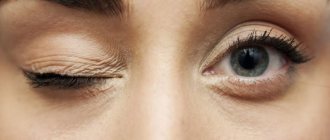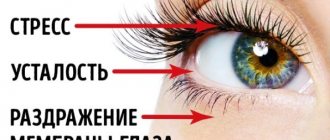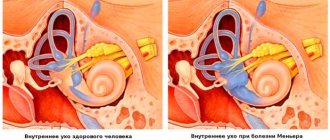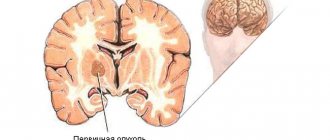A nervous tic is a sudden, repetitive movement that occurs as a result of involuntary contraction of a specific muscle group. For example, it is often said that “the eye twitches.” Twitching can affect different muscles, spread from one muscle group to another, and even cover almost the entire body.
Movements during tics are obsessive and a person cannot control them. When you try to suppress a tic, the tension increases and as a result the tic only gets worse.
The most common tic occurs in childhood, and it is detected somewhat more often in boys than in girls. It is believed that tics occur in 13% of boys and 11% of girls.
Causes of nervous tics
The causes of tics are usually grouped as follows:
- primary tics
caused by psychogenic factors. In this case, there are no organic pathologies. The occurrence of a tic can be caused by stress, fear, depression, and neurosis. It is this type of tics that most often occurs in children. The cause of a nervous tic in a child can be psycho-emotional trauma, increased anxiety, obsessive fear, attention deficit hyperactivity disorder (ADHD); - secondary tics
. In this case, the tic is a consequence of any diseases that cause disruption of brain activity. These may be infectious diseases (encephalitis), intoxication, brain injury, cerebrovascular accidents; - hereditary tics.
How does this happen?
Due to vigorous activity near computers or phones, books, which requires the work of the facial muscles of the eyes, forehead and face as a whole, the eyes become very tired. This happens to such an extent that the neurotransmitters responsible for muscle function cease to be synthesized correctly. That is, chemicals do not transmit impulses from neurons to muscle tissue. The eyelid begins to twitch. Disruption of neurotransmitters is associated with stress and fatigue, and people often notice this. If the day turns out to be unpleasant, then the eye will definitely begin to twitch. Myokymia can be caused by some antipsychotics and nervous system stimulants in combination with difficult life events.
Symptoms of a nervous tic
Nervous tics
Involuntary movements can affect only one muscle group - such tics are called local
.
There are also simple and complex tics. A simple tic is a complex of the simplest movements of the same type. With a complex tic, involuntary movements affect several muscle groups. A severe type of the disease is a generalized tic
, affecting almost the entire body. With this type of tic, involuntary movements usually begin in the face, then involve the muscles of the neck, shoulders, arms, chest, abdomen and back, and even legs.
Most often, tics affect the facial muscles. In this case, such movements as blinking, moving the lips, opening the mouth, moving the eyebrows, and twitching the nose are characteristic. When a tic spreads to the neck and shoulders, nodding and shaking of the head are typical. Tic spreading to the limbs is expressed in the form of flapping of arms, clapping of palms, stamping and jumping.
A group of vocal manifestations is also distinguished. In this case, screams, coughing, howling, uttering curses, and incoherent speech may be observed.
Why do the upper and lower eyelids twitch?
Pulsation of the upper eyelid is observed an order of magnitude more often than the lower eyelid. The upper eyelid twitches especially often in women, because the weaker sex is more emotional. With the same frequency, unpleasant spasms are caused by reading in the dark, abuse of e-books, phones, the Internet - all this overstrains the eyesight and can cause trembling of the upper eyelid.
Among the serious pathologies that cause the right or left eye to twitch, doctors also identify Parkinson's disease, Bell's palsy, immune system failure, inflammation of the optic nerve, and amyotrophic lateral sclerosis.
The causes of involuntary twitching of the lower eyelid are most often associated with damage to the facial nerve, because an important branch passes just below the eye.
With hypothermia, against the background of osteochondrosis, malocclusion, the facial nerve becomes inflamed or its dysfunction develops. This condition is often accompanied by tics. Treatment in such a situation is mandatory, especially as it progresses.
When should you see a doctor if you have a tic?
Every person can experience involuntary muscle contractions under great emotional stress (for example, eyelid twitching). If such manifestations are observed within 2 weeks (including repeated single tics), then this is already a disease. Tics that last less than a year are called transient (temporary). If a tic persists for more than a year, it is called chronic. Simple transient tics usually go away on their own. However, it is still necessary to see a doctor to reduce the risk of the tic becoming stronger and stronger.
What causes eye twitching?
At least once uncontrollable twitching or blinking of the eye was observed in every person. This condition is scientifically called a nervous tic.
and can last several seconds and up to 10 minutes, after which it goes away on its own. But in some cases, the tic lasts much longer or is repeated frequently.
The eye itself does not pulsate during a tick
– a person feels a spasm of the muscles of the eyelid (upper or lower).
There are several names for such short-term movements of muscle tissue:
Advertising:
- hyperkinesis;
- nervous tic;
- blepharospasm;
- dyskinesia.
Doctors put nystagmus in a separate line
- vibration of the eyeball itself at a certain speed, rhythm, which has nothing to do with a nervous tic. Symptoms of tics are frequent involuntary contractions of the eyelid muscles of the right or left eye, with no pain or visual disturbances. If the eye twitches, the causes and treatment for adults and children are varied, because there are many prerequisites for such a phenomenon.
Headache, migraine and a feeling of the head being squeezed in a vice are common complaints from patients of all ages. The main cause of these diseases is cerebral vascular spasms. Read more in the article: “cerebral vascular spasms - symptoms and treatment.”
Types and causes of nervous tics
If the eye begins to twitch strongly and regularly, you should seek help from a specialist - this condition is pathological. Nervous tics are divided into three types by origin:
- Primary
(psychosomatic). They occur as a result of disturbances in the functioning of the nervous system or due to stress. They often go away on their own. - Secondary
(symptomatic). Caused by diseases of the brain or develop against the background of other pathologies. Their causes include the consequences of head injuries, metabolic disorders, past infections, vascular diseases, nerve fibers, tumors, and ophthalmological diseases. - Hereditary
. Some types of central nervous system disorders are inherited and are accompanied by constantly or periodically appearing spasms of the eyelids.
Depending on the nature of the spasm, eye twitching can be simple or complex. In the first case, the eye muscle contracts once. A complex tic means that a prolonged and double spasm occurs, which can be complemented by twitching of the eyebrow, lower eyelid, and facial muscles.
Sometimes a nervous tic is so weak that the patient does not notice it, but those around him point out the problem: an examination for such a nuisance is also necessary!
Common Causes of Eye Twitching
Often a person notices that the right eye twitches regularly. The reasons for what to do in this case are the doctor’s tasks. Typically, nervous tics of the right and left eyes are of a primary nature and are associated with mental overload, anxiety, stress, and pass rather quickly when psychological comfort is created. But sometimes the reasons that the eye twitches are due to an unbalanced diet and vitamin deficiency, especially a lack of B vitamins, magnesium, calcium, and aluminum.
Sweating in our body is the same natural and necessary function as breathing. But sometimes sweating is excessive - in this case hyperhidrosis is diagnosed. Read more in the article: “causes of heavy sweating.”
Sometimes the reasons why the eyelid twitches are more banal. Thus, intense and prolonged work at the monitor, frequent use of gadgets, and work with increased attention can lead to a similar problem. This is due to severe visual strain and resulting spasm of the eye muscles.
Advertising:
Of the easily eliminated causes of nervous tics, experts note the following:
- systematic lack of sleep;
- smoking a lot of cigarettes;
- abuse of alcohol, caffeine;
- taking certain medications;
- foreign body getting into the eye;
- dry cornea, dry eye syndrome.
Diseases as a cause of tics
If a nervous tic occurs in the right eye or the left eye twitches, what to do, what are the reasons? By excluding the above factors and paying attention to other signs, we can draw a conclusion about the nature of the disease that provoked the uncontrolled blinking of the eye. Examples of such pathologies are given in the table.
| Pathology | Description | Additional symptoms |
| Flu | Acute respiratory viral infection | Severe intoxication, muscle spasms and pain, high fever, catarrhal symptoms |
| OCD – obsessive-compulsive disorder | A syndrome with the appearance of obsessive thoughts, in response to which compulsions arise (certain actions) | The appearance of fears, obsessive desires, absurd ideas, mental disorders of a progressive nature |
| Blepharitis | Inflammation of the eyelids | Redness of the eyelids, sticking of eyelashes, photophobia, headaches |
| Conjunctivitis | Inflammation of the conjunctiva | Redness of the white of the eye, discharge of pus, swelling of the eyelid, lacrimation, itching |
[
]
Treatment of nervous tics
Nervous tics are treated by a neurologist. In case of primary tic, a psychotherapist can help. Primary tics in children usually go away with age. To relieve symptoms and speed up recovery, it is recommended:
- normalization and adherence to the daily routine. It is necessary to get up, eat and go to bed at approximately the same time;
- proper and balanced nutrition;
- active lifestyle, sports, walks in the fresh air;
- eliminating excessive mental stress;
- reduction of psycho-emotional stress. Normalization of relationships in the family, and for the child also at school, is of great importance.
If tic manifestations are severe, the doctor may prescribe medication. For secondary tics, treatment is primarily aimed at combating the underlying disease that caused the tic. In most cases, with successful treatment of the underlying disease, the tic disappears.
Massage and reflexology are also used to treat tics.
4.Treatment
In most cases, the eye twitching will stop on its own if you simply get some rest and/or limit your intake of alcohol, coffee, and tobacco. Ticks due to dry eyes and corneal irritation can be treated with drops such as artificial tears - they often help.
There are no effective treatments for benign essential blepharospasm, but there are a number of treatments that can reduce the severity of the disease. One of them, used for treatment in the USA and Canada, is Botox injections
.
When a small amount of botulinum toxin is injected into the eye muscle, spasms decrease or disappear for several months. But the effect gradually wears off and injections are usually repeated. There are also medications
prescribed for mild cases of benign essential blepharospasm, but their effectiveness is approximately 15%.
Some patients benefit from alternative treatments for blepharospasm
- acupuncture, manual therapy, diet therapy, hypnosis. But the benefits of these techniques have not been scientifically proven.
If none of the treatments for blepharospasm are effective, your doctor may recommend a myectomy.
. This is a surgical procedure in which some of the muscles and nerves of the eyelids are removed.
For the treatment of hemifacial blepharospasm
neurosurgical operation
may be prescribed , the purpose of which is to reduce the pressure of the artery on the facial nerve. But such an operation, although it gives a permanent result, can be associated with serious complications and permanent side effects.
Prevention and treatment
Knowing the reasons, it will be easier to cope with a twitching eyelid and prevent the situation from worsening. Here are some simple options:
- give the body the right amount of time to rest and recover, organize sleep correctly,
- drink less caffeinated drinks, it is better to replace them with water,
- try not to create or enter into stressful situations, but treat everything calmly and judiciously,
- do gymnastics for the eyes,
- give your eyes a rest between activities,
- do not drink alcohol,
- properly organize the workplace, adjust the light and ventilate the room.
treatment of myokymia
In some cases, these simple steps will be enough to get rid of the problem. But if this does not bring any results, you need to consult a doctor. Together with him, undergo examinations of the nervous system, vision, and internal organs, after which he will select the appropriate treatment (medicines, lifestyle adjustments, lenses, glasses). You should contact a specialist in any case, as self-medication can worsen the situation.









